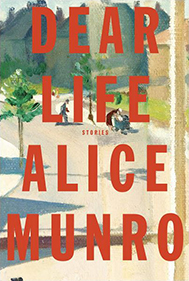by David Abrams
Buy on NOOK »-
March 11, 2013
Opening Round
-
Alice Munro
1Dear Life
v.
4Building StoriesChris Ware
-
Judged by
Charles Yu
Both of these were so good. As I type this out I’m realizing that I haven’t quite made up my mind. Did I just sit down and start writing, hoping that I’d figure it out? Maybe. Was this maybe not the greatest plan? Maybe not. And what if I don’t figure it out? Can this end in a tie? Do we go to overtime?
Both works are concerned with truncation, either literally or, in the case of Munro’s story collection Dear Life, in a more conceptual sense. Many of Munro’s stories feature people in conditions of geographic and emotional isolation. People living in quiet towns, living mostly quiet lives. Quiet, of course, does not necessarily mean peaceful: This is a quiet that can be suffocating at times, a quiet so pervasive throughout the stories that it’s almost part of the scenery. Call it the Munrovian Northern Atmospheric System, an extreme low barometric pressure that extends across all of these Canadian towns, connecting them, covering them under a blanket of emotional force per unit area exerted over the landscape, an invisible equilibrium of suppressed potential that can, after decades, suddenly and explosively burst into a downpour of violent and unpredictable weather. These people are mysteries to those who love them, mysteries even to themselves. Munro catches them at a moment, at the moment, the moment of being faced with a choice, or with the consequences of their choice, or with the long-buried memory of a choice that ends up defining and shaping a life.
Line by line, Munro’s collection offers more pleasures. About a small town:
…Population 1,553.
Why do they bother to put the 3 on?
Every soul counts.
Or how about this: “My father took a nap too—maybe fifteen minutes on the porch with the Saturday Evening Post over his face…” Oh man, that nap. I want that nap. I used to take that nap—before I had kids.
And then finally there’s this: “I lived when I was young at the end of a long road, or a road that seemed long to me.”
It’s the first line of the title story, and for my money, the best line in the book. In one sentence, Munro takes us on a complete round trip, to childhood and back to the present moment, drawing in a single stroke a continuous unbroken line of sight that spans a life. She compresses time, and then elongates it, folds it and layers it and works it into complex, tangled shapes.
And then, when you want resolution, there is the truncation I mentioned. There are few moments of epiphany here. Instead what Munro gives us, over and over again, are endings like guillotines, endings that slam down on the back of your neck with the speed and force of a sharp, heavy blade. Reading her endings is like having your breath chopped in half—you can’t ever get the full exhalation. You turn the page and you go, oh hell no, because even as your mind is still reading your eye is registering the fact that there is too little text remaining for there to be any kind of release or satisfaction—the story is going to end one paragraph before you want it to, and it literally takes your breath away.
If Dear Life is a literal collection of stories that features truncation in an abstract sense, then Building Stories is the inverse—it’s only a collection in a more conceptual sense, but it features truncation in a literal sense.
The unnamed protagonist of Building Stories is a young woman living a lonely life. As a girl, she lost the lower part of left leg, her foot and most of her calf, in a boating accident. Because Ware is working with pictures as well as words, the leg—the partial absence of a leg—is always there (or not there). In a purely textual work, the limb could have faded into the background, could even have been forgotten for long stretches. But it’s much more prevalent here, much harder to forget, when we are reminded, in frame after frame, of the prosthetic, or the stump. We see it because Ware draws it there for us to see, can place it there without word or comment.
Which goes to the fundamental difficulty of comparing these two works. By virtue of his mixed medium, Ware has many more tools at his disposal than Munro or any other straight-up prose writer: figure, expression, color, framing, and composition, to name just a few. It does not diminish the power and mastery of Munro’s stories to say that Ware’s work offers more dimensions: It literally offers a third one. It comes in a beautiful box (one that is itself covered with bits of narrative and paratext), and you open it up and pieces of art spill out, things to flip through and unfold and spread all around you so that you are sitting in it. My wife and I read Building Stories together over the course of a few nights, trading pieces, comparing notes, exchanging sighs when we finished each heartbreaking fragment of the story.
It’s not so much the story itself that is heartbreaking. Dear Life really is amazing, line by line, and to be honest, out of the 14 pieces of Building Stories, hundreds of pages and thousands of panels, not many individual moments stand out as particularly memorable. This is not surprising: These are fairly mundane lives. Which is, I think, part of the poignancy. For the most part, these are non-events, non-moments: the middle of the day, the inexplicable melancholy of watching your child play, happy to be with you, but otherwise alone. Ware’s people are trapped in their boxes, inside their apartments, inside their panels, nothing much dramatic happening for years on end. You don’t even really know where to start: This is sequential art on a small scale that has no sequence on a larger scale. What happens is cumulative. As you read piece after piece, fumble through the box, trying to figure out what to choose next, trying to formulate your own story, your own narrative for these characters, something happens. It creeps on you, then it climbs up your back, and then it tickles your neck, and then makes your scalp tingle and it finally dawns on you. You’re trying to build stories. You’re the builder. The characters, they’re the builders. And these moments, this loose collection of items, disparate in size, with no obvious connections, these bits are the raw materials.
And everything Munro offers, Ware offers, too. The malleability of time and memory, so masterfully manipulated by Munro, is here, too: Pictures are always in present tense, except when they’re not, and Ware captures the fuzziness of past and present, the suddenness of nostalgia, the disorder of our chronologies. And as masterful as Munro’s designed amputations are, it’s even more devastating with the Ware, because you can see this same truncation coming as you read the panels—you know that you are boxed in from the beginning, and running out of space. And you are truncated on both sides: There is no beginning or end to any of these pieces as singular stories, nor is there any beginning or end in a larger sense.
That’s what it comes down to, for me. As good a book as Dear Life is, it’s definitely a book. Building Stories is something else altogether. It’s a book, but it’s more than a book. It’s almost unfair. I mean, this is the Tournament of Books, right? Not the Tournament of Fifteen Books and One Self-Contained Multimedia Sequential Art Narrative Architecture and Environmental Space. It’s like inviting the best 16 basketball players on Earth to have a one-on-one tournament and then telling one of them that, in addition to a basketball, he can also use a baseball bat. OK, that analogy maybe isn’t perfect, but you get my point. Ware wins, but he’s playing with extra equipment.
Match Commentary
By Kevin Guilfoile & John Warner
John: Alice Munro is some kind of sorceress. Just when I think I can’t get invested in another story involving a quiet young woman taking a train either to or from Toronto, she’s thrown me an emotional cross-body block with nothing more than a gesture.
I can’t really do more justice to describing the effects of the Munrovian universe than Charles Yu. I’m grateful for his articulation of an effect that I’ve always fallen back on calling “magic.” Reading Dear Life takes me back to when I first fell in love with the notion of trying to write stories, when Alice Munro, and writers of a similar realist stripe (Carver, Ford, Beattie), presented the challenge of unlocking meaning from everyday events.
I say “takes” me back because I am still in the process of reading the book as I dole the stories out at the rate of one per week. I’m doing the same with George Saunders’s Tenth of December because I’ve long felt this is the best way to read stories by a single author. I love burgers, fries, and milkshakes, but I need one of each to make a truly satisfying meal.
I think this is one of the reasons why short story collections have a hard time advancing in our Tournament, with the notable exception of A Visit From the Goon Squad, which was billed as a novel, even though it really isn’t one. Clearly, Dear Life had a better than good shot in this matchup. Its status as short stories was no handicap. Its biggest shortcoming for Judge Yu was that compared to Building Stories, it’s just a “book.”
Kevin: There is something special about pulling Building Stories off the bookstore shelf. It feels like a board game more than a book. It’s wrapped in cellophane, so you can’t really sample it. The bottom of the box has some images of the contents, but even after looking at them you might be forgiven for thinking you need a pair of dice and a shoe token to get started.
I opened it and started to peel away the layers. It’s transfixing. I could have been immersed in it for hours except for recurring interruptions during which I had to stop my cat from sitting inside the box. Most of Ware’s panels are wordless and cinematic. He uses crane shots and zooms and dolly shots and pans.
We have tried to introduce graphic novels into the ToB before. In each case the comic has been run over by the regular old novel. It just seemed so slight in comparison. I always thought to make it work we had to find a graphic novel that was equal to the prose work in length. We needed something epic—perhaps a compilation like Brian Wood’s Local or even Ware’s previous Jimmy Corrigan collection. But Building Stories will take second to none in this tourney in terms of ambition. It’s a remarkable work of both art and narrative.
John: You and I had the pleasure of meeting and even sharing a stage (Dave Eggers’s stage) with Chris Ware in Chicago once. It was right around the release of Jimmy Corrigan: The Smartest Kid on Earth, which I think both of us were pretty gaga over at the time. I remember telling him so, and he got a pained look on his face lamenting something about how off the yellows were in the original printing. I knew at the time that this guy was an artist in all senses of the word.
I picked up Building Stories the week of its release, feeling a little giddy as I handed over my credit card. It was clear the Barnes & Noble employee had no idea what I was buying, turning the box over several times, giving it a good inspection before scanning the ISBN code. I imagine she figured it for some kind of puzzle or craft kit. In our world, a giant box of Chris Ware is akin to a major holiday, but these incidents remind me that our world is pretty damn small.
That package sat on my shelf for three and a half months, as I realized I was simultaneously too amped for it and intimidated by it. I was worried about it meeting my expectations, except that I didn’t even know what my expectations were.
Finally, knowing that this exercise in group thinking was looming, I broke it open, admired the amazing packaging, and then dug in at random and read it, or experienced it, or whatever word we use to describe what happens when we interface with this kind of work. My encounter with Building Stories was very close to Charles Yu’s. I would pick up one object, turn it over, flip through it and then dive in. Because there is no linear structure, no suggested order, it seems like everyone’s reading experience is going to be a little different. I found myself doubling back several times, seeing previously read pieces in a new light having read some subsequent selection. I’m not even close to exhausting the possibilities of the full package of material.
Yu’s right, it’s something else.
Kevin: Chris Ware not only lives in Chicago, he lives rather close to me. And so you would think that I would run into him with some frequency, the community of Chicago writers and artists being relatively intimate. But I think I’ve only met him the one time that you mention.
What do I remember about that night? That Ware was a ticking time bomb of talent. His weekly feature in the indie newspaper New City (and then the Reader) was revered in the cartooning and art world, but at that time I don’t know if his fame had expanded much outside those circles, or even much beyond the borders of Chicago. Dave Eggers was in town to promote his runaway bestselling memoir and was giving a talk at the Harold Washington Library downtown. Eggers’s readings were like rollicking tent revivals back then, and Chris had been enlisted as a hip opening act. You and I were invited as a kind of freakish, literary sideshow. If Chris Ware were a ticking time bomb, we were more like ticks—parasites, feeding off the audience of our much larger hosts.
The audience was huge. It filled the giant library auditorium and spilled over into not one but two additional rooms where the show could be seen on closed circuit. To this day it’s the largest crowd I have ever performed for. I remember Eggers not only signed books for every person there—it was more than 1,000 folks, as I recall, but sat and talked with each person in a long, long line of them, one on one, late into the evening. And I remember Chris as being shy, polite, funny, and, as you say, the subject of a lot of green room fawning by us.
We were both huge fans of his work when it ran weekly. And some of the comics in Building Stories have run individually in other publications—the New York Times, I think, and the New Yorker. But this project demonstrates that he is a marathoner, not a sprinter. If Alice Munro is a sorceress of short-form prose, Chris Ware is a wizard of the long-form comic. As good as an individual Ware panel can be—and they can be brilliant—the pieces in this collection add up to so much more. This box is a Tardis, and the many rooms inside it are a treasure. Building Stories will be on my shelf when I die.
John: Our last ambitious “book, but also not” entrant, Nox by Anne Carson, made it through a round, but couldn’t sustain the momentum. Building Stories has the feel of a real contender for the whole thing, possibly upending the status quo of the ToB once and for all.
Tomorrow, we have two of my personal favorite books of the year by established authors who are perhaps hitting an even higher gear, May We Be Forgiven by A.M. Homes, and the already ToB battle-tested Billy Lynn’s Long Halftime Walk by Ben Fountain.
























